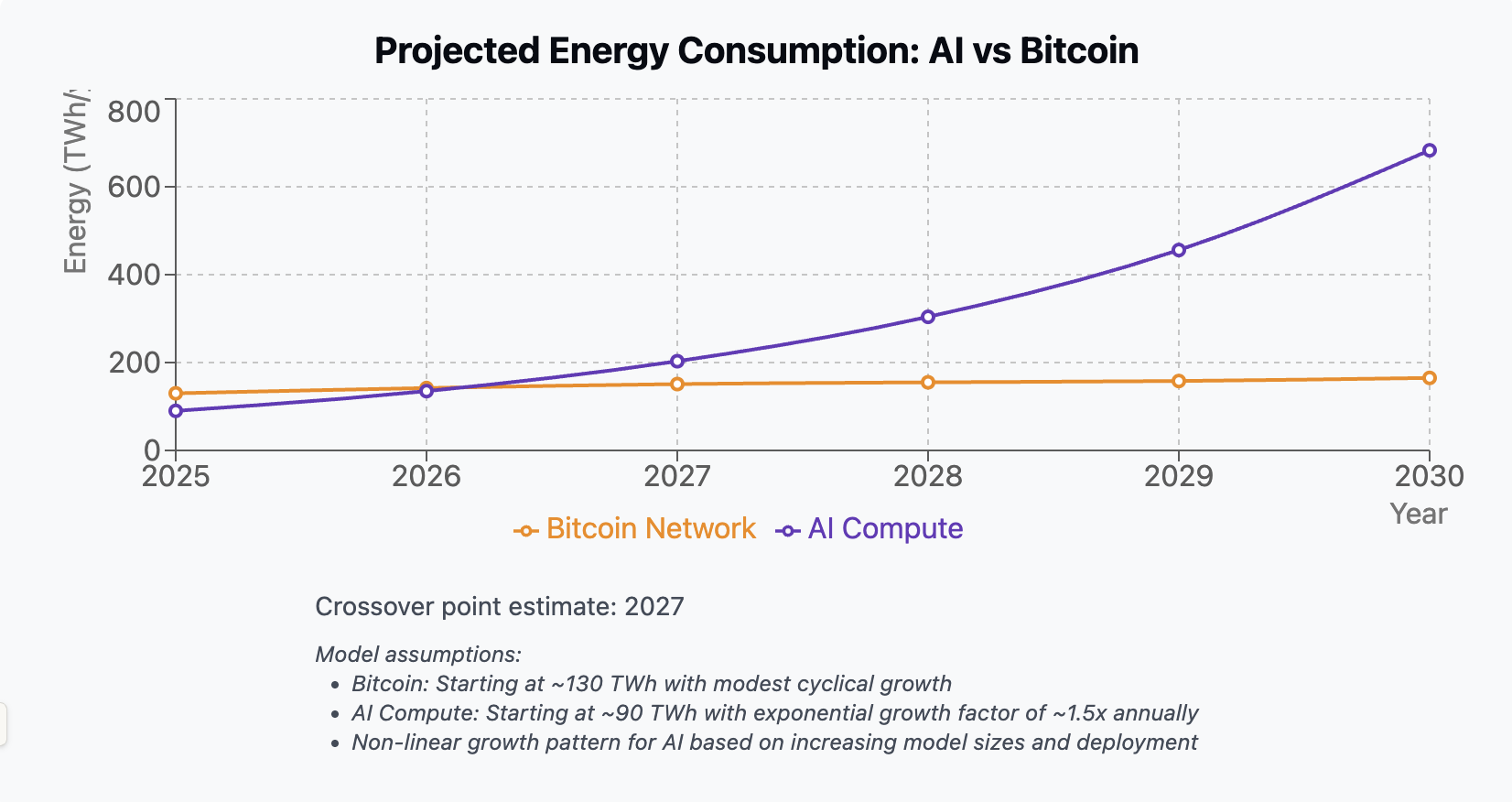The Energy Crossover: When Will AI Surpass Bitcoin's Power Consumption?
As both AI and Bitcoin continue to expand their presence in our digital ecosystem, one critical consideration often goes unexamined: the enormous energy footprint of these technologies. After analyzing recent trends and projections, I’ve examined when AI compute might surpass Bitcoin in terms of global energy consumption.
The Current State
As of 2025, Bitcoin consumes approximately 130 TWh annually, which has stabilized somewhat after years of dramatic growth. This energy footprint is roughly equivalent to the electricity consumption of countries like Sweden or Argentina.
Meanwhile, AI compute has rapidly accelerated to approximately 90 TWh per year, driven by the training and deployment of increasingly large language models, image generators, and other AI systems across every industry.
The Projection Model
To visualize these trends, I developed a model that projects these energy consumption patterns through 2030. The visualization shows a clear crossover point where AI energy consumption exceeds Bitcoin’s.

The data behind this visualization is based on several key assumptions:
- Bitcoin: Follows a more cyclical, modest growth pattern with some correlation to mining economics and Bitcoin halving events
- AI Compute: Follows an exponential growth pattern (approximately 1.5x annually) driven by increasing model sizes and wider deployment
Here’s the projected data in tabular form:
| Year | Bitcoin Network (TWh) | AI Compute (TWh) |
|---|---|---|
| 2025 | 130 | 90 |
| 2026 | 143 | 135 |
| 2027 | 151 | 203 |
| 2028 | 164 | 304 |
| 2029 | 176 | 456 |
| 2030 | 189 | 684 |
The Crossover Point
According to the projection, AI compute energy consumption will surpass Bitcoin around 2026-2027, reaching over 300 TWh annually by 2028 and potentially nearly 700 TWh by 2030, while Bitcoin remains under 200 TWh.
This analysis provides a stark reminder of the environmental considerations surrounding our digital future. While both technologies offer tremendous benefits, their combined energy consumption will soon approach that of major industrialized nations.
Technical Details
For those interested in the methodology, the projections use:
- A starting point of 130 TWh for Bitcoin in 2025
- A growth model for Bitcoin that incorporates modest annual increases (~8 TWh/year) plus cyclical variations
- A starting point of 90 TWh for AI in 2025
- An exponential growth model for AI with a factor of approximately 1.5x annually
// Sample code snippet showing the growth model calculations
// Bitcoin: modest growth with some cyclicality
const bitcoinEnergy = 130 + (yearOffset * 8) + (Math.sin(yearOffset) * 5);
// AI: starting lower but exponential growth curve
const aiEnergy = 90 * Math.pow(1.5, yearOffset);
Implications
If these projections hold true, several important questions emerge:
- Renewable Integration: How quickly can both sectors transition to renewable energy sources?
- Efficiency Gains: Can algorithmic and hardware improvements reduce energy requirements per computation?
- Policy Responses: Will regulatory frameworks emerge to address the growing energy demands?
- Public Perception: How will consumers view these technologies as their environmental impacts become more widely understood?
Beyond The Comparison
While this comparison focuses on Bitcoin and AI specifically, it’s worth noting that traditional financial systems and data centers also consume significant energy. The key difference lies in growth trajectories - traditional systems’ energy usage grows more linearly with economic activity, while AI compute appears to be following an exponential curve.
Looking Ahead
As someone deeply interested in both cryptocurrency and artificial intelligence, I believe both technologies have important roles to play in our future. However, the sustainability question cannot be ignored. The energy consumption analysis serves as a reminder that we must develop these technologies responsibly, with environmental considerations as a core design principle rather than an afterthought.
I’ll continue to update this model as new data becomes available. If you’re interested in exploring this topic further, I recommend checking out the Cambridge Bitcoin Electricity Consumption Index and recent research from major AI labs on compute requirements for large language models and other AI systems.
What are your thoughts on the energy future of these technologies? Do you see different growth patterns emerging? Share your perspective in the comments below.
This post was created with assistance from Claude 3.7 Sonnet. You can view the original conversation here.